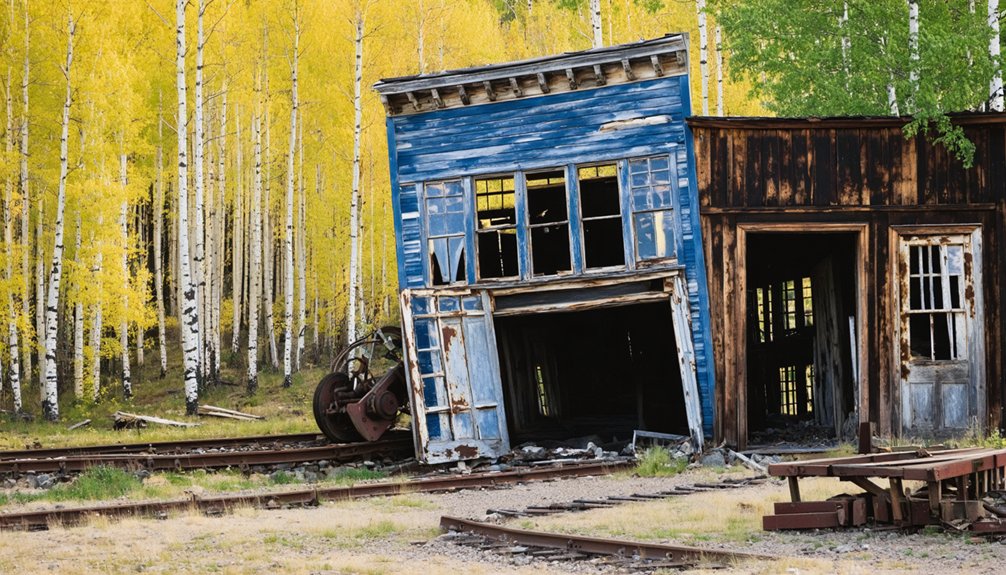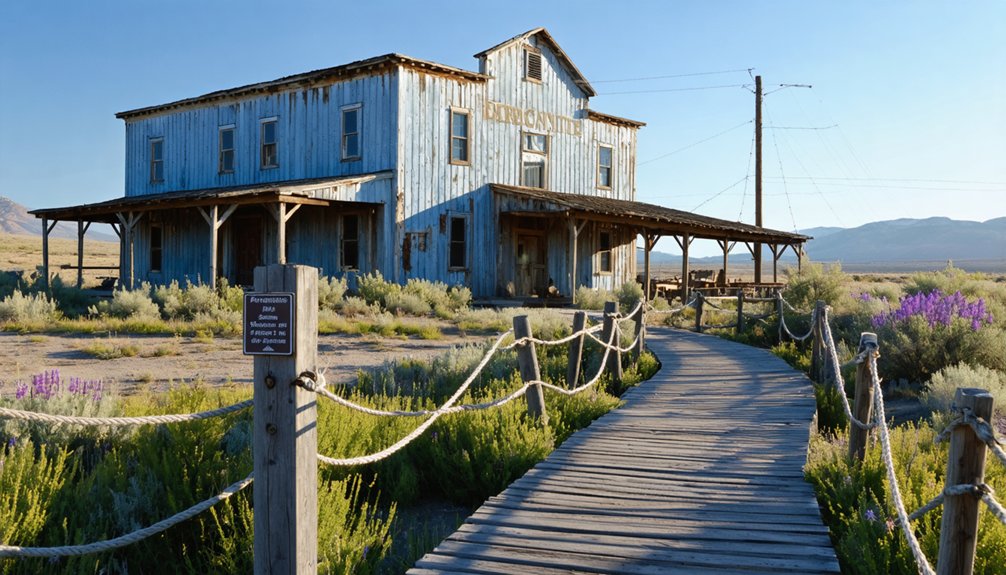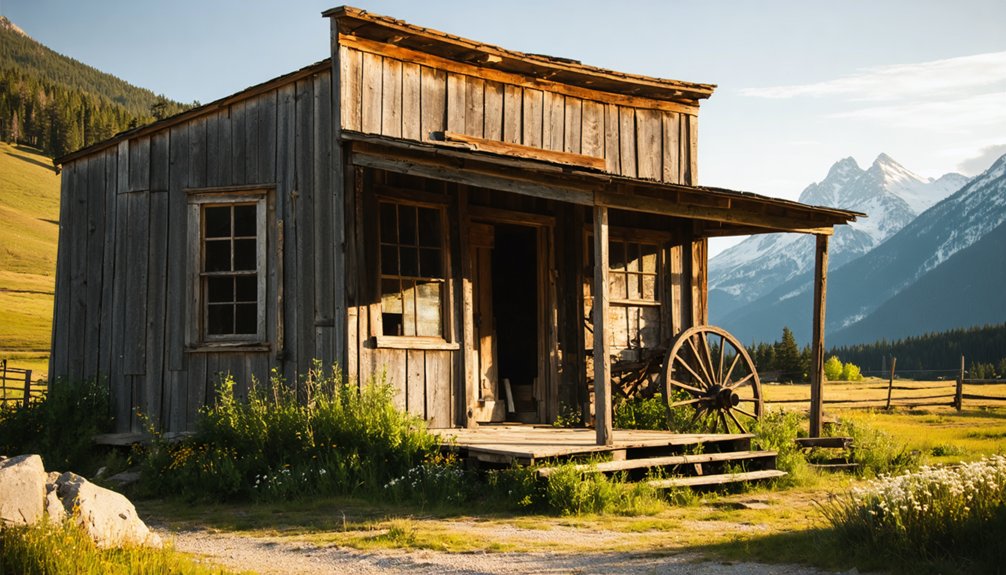Silverdale ghost town sits along the Guanella Pass Scenic Byway near Georgetown, Colorado. You’ll find this former mining community established during the 1879 silver boom before declining after the 1893 silver crash. A brief revival ended when a 1926 landslide destroyed the Colorado Central Mill. Today, you can explore the 0.75-mile Railbed Trail to view preserved ruins, mining artifacts, and dramatic mountain vistas. These silent remnants tell a compelling story of boom-and-bust frontier economics.
Key Takeaways
- Silverdale is a ghost town in Clear Creek County, Colorado, located in the Rocky Mountains near Georgetown along Guanella Pass Scenic Byway.
- The town’s mining operations began in 1879 during the silver rush but declined after the 1893 silver price collapse.
- Only concrete foundations and scattered metal remnants remain of the Colorado Central Mill and mining operations.
- Visitors can explore the 0.75-mile Railbed Trail around the abandoned mill site with a modest 113-foot elevation gain.
- The area is now a protected historic district where artifact removal and metal detecting are prohibited to preserve its mining heritage.
Location and Geographic Context of Silverdale
Nestled within the Front Range of the Rocky Mountains in Clear Creek County, Colorado, Silverdale ghost town occupies a distinctive position near Georgetown along the Guanella Pass Scenic Byway.
High in Colorado’s Front Range, Silverdale ghost town stands as a silent sentinel along the Guanella Pass Scenic Byway
You’ll find this historic site situated at high elevation above Georgetown, surrounded by the rugged topographic features characteristic of the Rocky Mountains.
The area lies close to South Clear Creek, which carves through the landscape and enhances the scenic trails connecting Silverdale to neighboring historic mining camps like Rockdale.
These waterways not only served practical purposes during the mining era but now provide picturesque elements for hikers exploring the region.
The mountainous terrain offers diverse exploration opportunities with trails evolving from wider dirt roads to narrower singletrack paths, all while showcasing the dramatic elevation changes of Clear Creek Canyon. Like many other mining sites in the region, Silverdale experienced significant development during the Silver Boom era before declining after the market crash of 1893. Visitors can access the area through the Silverdale Interpretive Site parking lot, which serves as the main trailhead for exploring the ghost town’s remains.
The Rise and Fall: Mining History Timeline
Silver Dale’s mining history began with an early boom in 1879 when prospectors established operations like Star of the West amid Colorado’s silver rush.
You’ll find that the devastating silver price collapse of 1893 struck a significant blow to the town’s economy, triggering population decline as miners sought opportunities elsewhere. This economic crisis mirrored the challenges faced in Leadville and Aspen as the Sherman Silver Purchase Act’s repeal devastated silver-dependent communities throughout Colorado. Senator Henry Teller advocated strongly for the silver industry before its collapse, having served since Colorado’s statehood.
Despite a brief revival attempt with the 1917 mill construction to exploit World War I mineral demands, Silver Dale’s mining operations ended permanently in 1926 when a landslide buried the site.
Rise of Mining Boom
Although the broader Georgetown area had seen mining activity since the 1860s with the discovery of the Belmont lode in 1864, Silver Dale’s mining boom truly accelerated following Colorado’s 1879 Silver Boom, which was initially triggered by significant discoveries in Leadville.
As you explore Silver Dale’s mining history, you’ll discover how the area evolved through:
- Implementation of increasingly sophisticated mining techniques as operations expanded from surface to underground extractions
- Development of essential infrastructure, including the Clear Creek Water Company’s reservoir system in 1874
- Economic impacts that rippled through Georgetown and surrounding communities
- Shift from primarily silver-lead operations to extraction of zinc, copper, and other minerals
The boom created unprecedented prosperity, with local mine ownership distinguishing Silver Dale from other mining districts dominated by outside capital interests. Silver Dale miners were among those affected by the numerous labor strikes that began appearing in Colorado’s mining history from 1881 onward. The devastating economic collapse following the Sherman Silver Purchase Act repeal in 1893 led to widespread unemployment and abandoned mining operations throughout Silver Dale and neighboring communities.
1893 Silver Crash
When President Grover Cleveland repealed the Silver Purchase Act in 1893, the impact on mining communities like Silver Dale was devastating. Silver prices plummeted by approximately one-third, instantly undermining the profitability of silver mining operations throughout Colorado.
Silver Dale, like many boomtowns, experienced rapid economic collapse as mines shut down or drastically reduced their workforce. Over 9,500 mining jobs vanished across Colorado, with Silver Dale’s population dwindling as unemployed miners sought opportunities elsewhere. Many families faced financial ruin as they were forced to abandon homes they had built over years of hard work in the mines.
The once-bustling community began its transformation into the ghost town you can visit today. This pivotal moment marked Silver Dale’s shift from prosperity to decline, exemplifying the vulnerability of single-industry towns. The mining tragedy was comparable to Silverdale Colliery which recorded 20 total fatalities throughout its operational history.
While some mining companies attempted to diversify into coal and gold, Silver Dale never recovered from the silver crash that altered Colorado’s economic landscape forever.
Brief Revival Attempts
Despite the devastating economic blow of 1893, Silver Dale witnessed several revival attempts throughout the early 20th century. Mining sustainability proved elusive as operations battled market volatility and extraction challenges.
The most significant revival challenges included:
- The 1917-1918 mill construction focused on zinc, copper, and lead extraction driven by WWI demand.
- Quick bankruptcy of the mill operation, resulting in equipment sales to cover debts.
- Intermittent Colorado Central Mine operations until the devastating 1926 landslide.
- Failed attempts to achieve profitability despite technological improvements.
Unlike many Colorado operations controlled by outside investors, Silver Dale’s mines were mainly locally owned.
The brief war-driven market opportunities couldn’t sustain long-term operations, leaving behind only foundations and tailings as reminders of these determined but ultimately unsuccessful revival attempts.
Exploring the Colorado Central Mill Ruins
When you visit the Colorado Central Mill ruins, you’ll encounter the massive concrete foundations built in 1917-1918 that once supported equipment for processing zinc, copper, and lead ores extracted from nearby mines.
The mill’s design incorporated gravity-fed ore processing systems, with evidence of sluices and tailings dispersal mechanisms still visible among the scattered rusted iron and deteriorated wooden structures. Located at an elevation of 10,000 feet, the site offers visitors a unique perspective on high-altitude industrial operations of the early 20th century. The ruins are set against the stunning Rocky Mountains, providing an exceptional backdrop for exploration and photography.
Despite its protected historic district status prohibiting artifact removal or metal detecting, preservation efforts have successfully maintained the site’s original layout and structural integrity, allowing visitors to witness authentic early 20th-century industrial mining architecture.
Mill Construction Features
The imposing Colorado Central Mill once dominated Silver Dale‘s landscape, covering two acres with its industrial presence. Its architectural design brilliantly utilized gravity to maximize efficiency in ore processing.
Engineers constructed the facility with ten stair-step terraces descending from ore-holding bins situated on flat ground at the top of the structure.
The mill’s industrial engineering techniques included:
- A gravity-assisted processing system that moved ore downward through various stages
- An enclosed coal-fired power plant generating steam for operations
- Strategically positioned near water sources including the forebay reservoir
- Concrete foundations built to support heavy machinery and withstand mountain conditions
Today, you’ll find only concrete pads and scattered metal remnants marking where this impressive industrial complex once stood, silent acknowledgment to Silver Dale’s mining heritage.
Ore Processing Operations
Built during the height of World War I demand for metals, the Colorado Central Mill began operations in 1918 as a specialized facility designed to extract valuable minerals from previously processed ore.
The mill targeted zinc, copper, and lead from the Colorado Central mines, Marshall tunnel, and Leavenworth Mountain.
You’ll notice the sophisticated mineral processing system employed gravity and pumped water, utilizing a Blake jaw crusher, 20-stamp mill, and buddle for ore extraction. This allowed efficient handling of large volumes of low-grade material at reduced cost per ton.
Despite its technical merits, the operation proved short-lived. The company quickly went bankrupt, leading to dismantling of equipment to pay outstanding debts and wages.
This closure effectively ended large-scale ore processing in Silver Dale, with no subsequent operations established.
Preservation Efforts Today
Today’s visitors to Silver Dale can explore what remains of the once-bustling Colorado Central Mill, which stands as a tribute to the area’s rich mining heritage.
Despite its historical significance, the site lacks formal landmark status, limiting access to preservation grants. Clear Creek County manages the trails but focuses primarily on access rather than structural preservation.
The preservation challenges include:
- Continuous exposure to harsh weather conditions accelerating deterioration
- Absence of protective coverings or stabilization measures
- Missing interpretive signage that would enhance visitor understanding
- Limited community involvement in structural preservation initiatives
While photographers and history enthusiasts frequent the concrete ruins, the site remains vulnerable to further decay without intervention.
The county’s management prioritizes trail maintenance and regulated visitor access, reflecting a balance between public freedom and resource protection.
Mining Operations and Precious Metal Production
Silver Dale’s mining operations represented a significant contributor to Colorado’s booming precious metal industry during the late 19th century, yielding extraordinary production values that frequently exceeded one million dollars annually and occasionally approached two million.
The Colorado Central Mine functioned as the primary operational hub, with multiple surrounding mines feeding ore to a centralized mill for processing.
Mining techniques evolved throughout the 1870s-1880s as local Georgetown inventors and operators expanded extraction capabilities.
You’ll find evidence of intermittent rather than continuous operations, reflecting the volatile economic impact of market conditions that characterized Colorado’s silver mining districts.
While competing with Central City for regional dominance, Silver Dale’s mines operated until 1926, when a catastrophic landslide effectively ended the site’s productive era.
Hiking the Historic Railbed Trail

Winding through Silver Dale’s historic mining landscape, the Railbed Trail offers visitors a relatively accessible 0.75-mile journey with modest elevation gain of 113 feet.
You’ll follow the remnants of an old railroad path, looping around the abandoned Colorado Central Mill before merging with Sporting Times Trail back to the parking area.
Trail conditions require vigilance as you navigate this protected historic district:
- Watch for scattered nails, glass, and metal sheets throughout the site
- Observe concrete ruins approximately 0.23 miles from the bridge crossing
- Explore visible historical artifacts including metal buckets, rails, and mining equipment
- Cross South Fork Clear Creek via the bridge near the parking lot
The trail network accommodates various skill levels, with portions even offering limited wheelchair accessibility to the mill ruins.
Photographic Opportunities and Viewpoints
Poised at the intersection of history and natural splendor, Silver Dale Ghost Town presents photographers with an exceptional array of visual narratives waiting to be captured.
The elevated vantage points along Guanella Pass Scenic Byway offer viewpoint accessibility for dramatic wide-angle landscape compositions featuring the ghost town against Rocky Mountain backdrops.
Apply various photographic techniques to maximize the site’s potential: capture reflections in South Clear Creek with long exposures, frame the Colorado Central Mill ruins in golden hour light, or document architectural details using midday sun to highlight textures.
Early morning fog creates ethereal atmospheres perfect for moody compositions, while seasonal changes—from summer wildflowers to winter frost—transform the visual story.
Wildlife photographers will appreciate the quiet environment ideal for capturing mountain birds and deer, especially during dawn and dusk.
Preservation Efforts and Visitor Guidelines

The preservation of Silver Dale Ghost Town balances visitor access with historical conservation through a thorough management framework established by multiple stakeholders.
Silver Dale’s preservation model showcases exemplary collaboration between organizations committed to historical integrity while ensuring sustainable public access.
Several preservation strategies coordinate environmental stewardship with historical education while providing clear visitor etiquette guidelines.
When visiting Silver Dale, remember to:
- Stay on marked trails to protect vegetation and sensitive archaeological areas
- Read interpretive signage that connects you to the site’s mining heritage
- Respect property boundaries between public access areas and private lands
- Follow watershed preservation practices outlined at footbridge information points
The collaborative efforts between Georgetown, Clear Creek County, Historic Georgetown Inc., and the US Forest Service guarantee this ghost town remains accessible while protecting its cultural significance.
The non-motorized recreational design deliberately limits environmental impact while maximizing educational opportunities about Colorado’s mining history.
Frequently Asked Questions
Are There Any Haunted Sites or Paranormal Stories About Silverdale?
You won’t find documented haunted legends or ghost sightings in Silverdale. Historical records and paranormal registries show no evidence of supernatural activity, unlike some neighboring Colorado mining ghost towns.
What Lodging Options Are Available Near the Silverdale Ghost Town?
In the nick of time, you’ll find Silverton offers your best lodging options near Silver Dale. Lodging reviews highlight historic inns, motels, and Campfire Ranch. Camping tips: consider Silver Summit RV Park.
Is Silverdale Accessible During Winter Months?
Yes, Silverdale is accessible during winter months, but only on foot. You’ll need to park at the Silverdale Interpretive Site and prepare for challenging snow conditions on ungroomed trails.
Were Any Notable Historical Figures Associated With the Silverdale Mines?
Like miners seeking glittering veins beneath barren ground, you’ll find Horace Tabor’s influence in Silverdale’s silver mining history. W.F. Kelso and Colonel William Moore provided historical significance through their Argentine district operations.
What Wildlife Might Visitors Encounter While Exploring the Area?
You’ll likely observe diverse wildlife sightings including mule deer, elk, mountain lions, coyotes, bobcats, and raptors like hawks and eagles. Local ecosystems also support trout, amphibians, and threatened Canada lynx.
References
- https://millefiorifavoriti.blogspot.com/2020/03/ghost-towns-of-vicksburg-and-winfield.html
- https://www.legendsofamerica.com/ghosts-of-clear-creek-canyon/
- https://georgetown-colorado.org/silverdale-trailhead-near-georgetown-colorado/
- https://letsjetkids.com/silverdale-trailhead-georgetown/
- https://www.fourteenernet.com/things-to-do/beaver-city-vicksburg-rockdale-silverdale-winfield
- https://localhistory.boulderlibrary.org/islandora/object/islandora:57943
- https://naturalatlas.com/ghost-towns/silver-dale-2255024
- https://www.coloradopast.com/index.php?category=ghosttowns&subcategory=northcentral&selection=Silver+Dale
- https://www.clearcreekcounty.us/DocumentCenter/View/12198/OS-Treasure-Hunt-Info-Packet-2021
- https://trails.colorado.gov/routes/184



